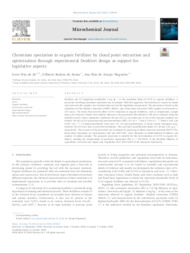Chromium speciation in organic fertilizer by cloud point extraction and optimization through experimental Doehlert design as support for legislative aspects.
Chromium speciation in organic fertilizer by cloud point extraction and optimization through experimental Doehlert design as support for legislative aspects.
Author(s): SÁ, I. P. de; SOUZA, G. B. de; NOGUEIRA, A. R. de A.
Summary: Brazilian and EU legislation establishes 2 mg kg?1 as the maximum limit of Cr(VI) in organic fertilizers. A procedure involving chromium speciation was developed. With this approach, the interference caused by humic acid present in the samples was circumvented and met the legislation requirement. The procedure is based on the adjustment of the alkaline extraction (USEPA 3060A), and cloud point extraction (CPE) applied to determine Cr(VI) traces. The issues that directly affect Cr(VI) extraction in organic fertilizers, such as temperature, sample mass, and extractor volume were studied. Moreover, the parameters that influence CPE were evaluated using the Doehlert matrix. Under optimized conditions, the use of 0.2 g of sample and 10 mL of the extractor solution was defined. For the Cr(VI) separation and preconcentration (CPE), 2% (m v?1) NaCl, 0.3% (v v?1) Triton X-100, and 0.05% (m v?1) 1,5 diphenylcarbazide were used. UV–Vis spectrophotometry or flame atomic absorption spectrometry (FAAS) were used as detection techniques. They provided quantification limits of 1.38 and 1.82 µg g?1, respectively. The accuracy of the procedure was evaluated by analyzing certified reference materials (NIST 2701, Hexavalent Chromium in Contaminated Soil and NIST 695, Trace Elements in Multi-Nutrient Fertilizer) and analysis of spiked samples. The proposed procedure is suitable for the determination of Cr(VI) in organic fertilizers, meeting the requirements of normative instruction (NI) n. 7 (04/2016) of the Brazilian Ministry of Agriculture, Livestock and Supply and Regulation (EU) 2019/1009 of the European Parliament.
Publication year: 2021
Types of publication: Journal article
Observation
Some of Embrapa's publications are published as ePub files. To read them, use or download one of the following free software options to your computer or mobile device. Android: Google Play Books; IOS: iBooks; Windows and Linux: Calibre.
Access other publications
Access the Agricultural Research Database (BDPA) to consult Embrapa's full library collection and records.
Visit Embrapa Bookstore to purchase books and other publications sold by Embrapa.

